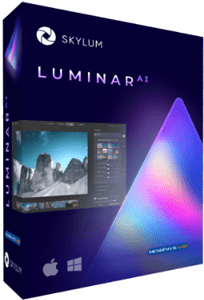

Here, the editing tools are broken down into a number of sections accessed through the collection icons on the side of the interface. Once you’ve selected a template, or decided to skip the template section you get to the main editing interface. This somewhat limits the usability of this feature, unless I’m overlooking something.
LUMINAR 4 VS LUMINAR AI DOWNLOAD
I’m not certain if it will suggest any templates that you’ve created yourself or even ones that you download from the Skylum store. The interface is quite nice though, and it does seem to correctly identify the type of image most of the time, but from what I can tell, the smart suggestion of templates only works for the included ones. This is kind of true because the Templates can contain AI-based adjustments which will react differently depending on the image, but at their heart, Templates are a collection of saved settings for the adjustments you’ll find in the edit section. These templates are basically glorified presets, although Skylum insists that they’re smarter than typical presets.
LUMINAR 4 VS LUMINAR AI SOFTWARE
Here the software will use AI to suggest a template for your image. The first stop on the curated journey is the “Templates” section. You can skip any of these and jump to the section you want. You don’t have to follow these steps exactly.

Regardless of how you get your image into the application, once you have selected a photo for editing, the software guides you through a workflow for editing, with a clear direction by the step tabs across the top of the interface. It can work as a stand-alone image editor on single images, or it can work as a photo workflow application with a catalog and limited asset management tools. It can work as a plug-in to Photoshop or Lightroom.
LUMINAR 4 VS LUMINAR AI MANUAL
By using AI, things that previously took many edits and manual work can be done with a simple slider. If you’ve never used Luminar before, it’s an image editing application that uses AI to automate many common tasks and the idea is that this is a new way of working, which should speed up your workflow. Review 1 - You’ve never used Luminar before It’s kind of like a “choose your own adventure” script. To reconcile this, I’ve essentially written two reviews. So, I’m left with shades of “Sliding Doors” trying to review this, and two very different experiences depending on if you had used Luminar before or not. Instead of a new and interesting photo editing experience, there is a legacy of broken promises and changed directions, and against that backdrop, Luminar AI promises to be an entirely new application, but is instead a downgraded experience with a few new features when compared to Luminar 4. However, if you have previously used Luminar 4 and earlier, it was a different story. For them, it was a departure from normal photo editing applications, and through those eyes, I could see how you could think this was a fascinating and different piece of software. The coverage I was reading was from people who had never used Luminar before. So, I took some time and thought about it for a while, until it occurred to me…. There was just a huge gulf between what some people were saying, and what I had experienced, and I hate writing negative things. I had actually written a pretty negative review, and I was almost going to publish it, but I held off because something was bothering me about it. I wondered what I was doing wrong because it seemed like I was reading about a completely different application. Since the application came out just before Christmas, I’ve seen many reviews and coverage extolling its virtues, but this wasn’t matching my experience with it. I’ve covered all sorts of things from hardware, to software, and I’ve never had as hard a time writing a review as I have with Luminar AI.

I’ve been writing reviews for over ten years.


 0 kommentar(er)
0 kommentar(er)
